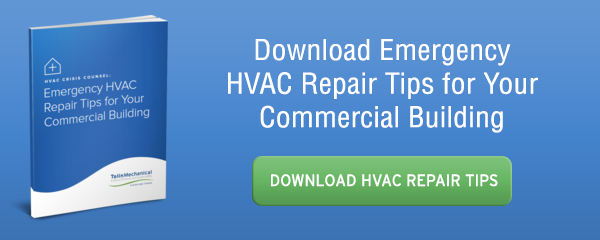The 5 Stages of an Emergency HVAC Repair Scenario

While dealing with an emergency HVAC repair at your commercial facility in Colorado, Virginia or Arizona is never an ideal situation, it doesn’t need to be a disaster either. In fact, like most other situations you deal with as the owner or manager of a commercial building, preparation and the ability to identify an issue as early as possible is key in making an emergency repair more manageable.
With that goal in mind, let’s take a look at the five stages of an emergency HVAC repair scenario. While each situation is different, nearly every repair scenario involves all of these steps to some extent.
Stage One: Discomfort
In all but the most abrupt and unpredictable situations, an upcoming HVAC repair is going to start with some level of discomfort in the building.
It may be problems with maintaining the proper temperature, often in a particular section of the building, and/or at a particular time of day. It could be due to temperature extremes or the fact that it’s taking far longer than it should for the system to raise or lower the temperature to acceptable levels.
Another initial symptom of a problem that can cause discomfort is poor air quality. Perhaps it’s a foul odor that doesn’t seem to have an obvious source, or air that’s too humid or too dry. Or, if the ventilation system is overtaxed or not functioning at all, the air inside the building can become stale and unpleasant.
Finally, discomfort can be caused by irritating noises accompanying the heating, cooling, or ventilation.
In the best of circumstances, you or your commercial building maintenance staff will notice these symptoms before they progress. Otherwise, these issues may be brought to your attention, especially if they’re localized, which takes us to the next stage.
Stage Two: Tenant complaints
Assuming your commercial building is routinely occupied, you’re likely to learn about the above symptoms when your tenants begin to complain. This will likely happen faster in a residential arrangement, simply because people are likely there 24/7 as opposed to an industrial or other commercial environment where workers are in and out throughout each day and perhaps never there at night.
The main point of recognizing this stage is to make sure tenants have the means to communicate quickly and clearly with building staff any time they notice something that seems to be amiss. It’s important to learn of an HVAC problem as early as possible, as undiagnosed issues and unaddressed repairs will only end up costing more time and money in the long run.
Stage Three: Investigation
Once a potential problem has been identified, it’s time to investigate the issue and be sure it’s isolated before attempting any sort of repair.
For some building staff, this is the stage in which they prefer to bring in a commercial HVAC services provider to handle the investigation. If no one on the staff has the expertise needed or the necessary tools to effectively isolate and diagnose the problem, professional help is the wisest course. However, if the staff has the knowledge, the tools, and the time to perform a thorough investigation with confidence, it can accelerate the process.
Stage Four: DIY or not?
Once the problem is identified, you’ll need to decide if the repair is something you and your staff can handle on your own or if you need professional help.
Of course, if you’ve already brought in professionals to investigate, it makes sense to allow them to make the repair as well, since you likely don’t have a qualified technician on staff. However, in some rare circumstances, a professional handling the investigation could find that the cause of the discomfort and tenant complaints is actually a very simple issue you can easily resolve on your own, in which case you could skip to the final stage.
If not, however, moving on to the next stage is the best option:
Stage Five: Contact your commercial HVAC company
If and when you decide that the needed repair is beyond the capabilities of your in-house staff, arranging for a qualified and trusted commercial HVAC company to handle it for you is always the best choice.
The pros have the tools, the experience, and the knowledge to handle any repair, as well as quick access to the necessary parts. That way, you can have the problem resolved as quickly and painlessly as possible, protecting your assets and improving the conditions your tenants are dealing with.
Stage Six: Resolution/Repair
Obviously, resolving the issue and performing the repair is the final stage in every emergency repair scenario. It’s important to recognize, however, that the length of time between Stage One and Stage Six is usually going to correlate to the overall cost and complexity of repairs, the level of tenant dissatisfaction that develops, and the possibility of additional consequences related to the root problem.
The sooner an HVAC problem can be identified, properly diagnosed, and effectively resolved, the better the situation is for everyone involved, and the more cost effectively it can be handled. To learn more, find out these three unavoidable signs your business needs a new HVAC system.

